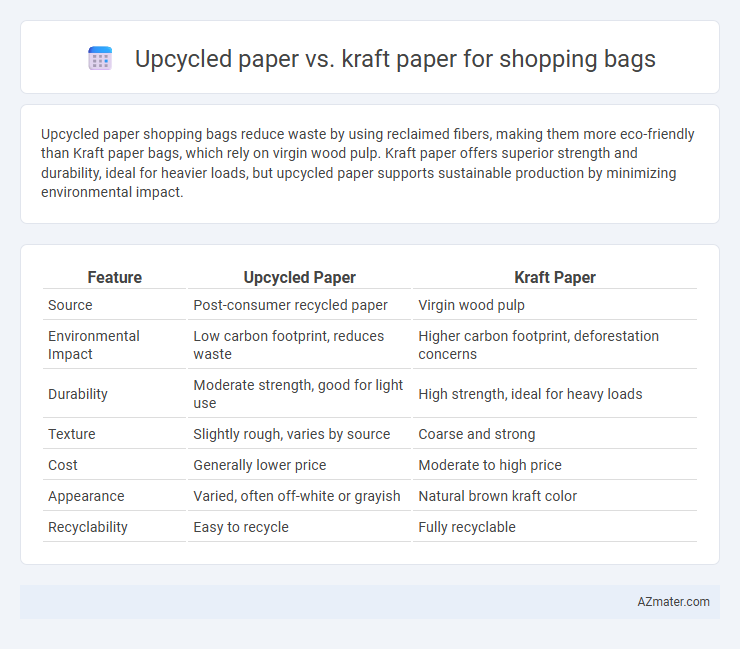Upcycled paper shopping bags reduce waste by using reclaimed fibers, making them more eco-friendly than Kraft paper bags, which rely on virgin wood pulp. Kraft paper offers superior strength and durability, ideal for heavier loads, but upcycled paper supports sustainable production by minimizing environmental impact.
Table of Comparison
| Feature | Upcycled Paper | Kraft Paper |
|---|---|---|
| Source | Post-consumer recycled paper | Virgin wood pulp |
| Environmental Impact | Low carbon footprint, reduces waste | Higher carbon footprint, deforestation concerns |
| Durability | Moderate strength, good for light use | High strength, ideal for heavy loads |
| Texture | Slightly rough, varies by source | Coarse and strong |
| Cost | Generally lower price | Moderate to high price |
| Appearance | Varied, often off-white or grayish | Natural brown kraft color |
| Recyclability | Easy to recycle | Fully recyclable |
Introduction to Sustainable Shopping Bags
Upcycled paper and Kraft paper are popular materials for eco-friendly shopping bags, each offering distinct environmental benefits. Upcycled paper reduces waste by repurposing discarded paper products, lowering the demand for virgin resources and minimizing landfill contributions. Kraft paper, known for its durability and biodegradable properties, is made from sustainably sourced wood pulp, making it a strong and recyclable option for sustainable packaging.
What is Upcycled Paper?
Upcycled paper is created by repurposing waste paper and other discarded materials to produce a sustainable, eco-friendly alternative to traditional paper products. It reduces environmental impact by diverting paper from landfills and minimizing the need for virgin fibers, making it an ideal choice for shopping bags. Compared to Kraft paper, which is made from virgin wood pulp and known for its strength and durability, upcycled paper emphasizes circular economy principles by reusing existing resources without compromising functionality.
What is Kraft Paper?
Kraft paper, made from wood pulp through the kraft process, is known for its strength and durability, making it ideal for shopping bags that require high tear resistance and load-bearing capacity. Its natural brown color and coarse texture provide an eco-friendly appearance while offering superior packaging protection compared to typical recycled papers. Compared to upcycled paper, kraft paper delivers enhanced moisture resistance and structural integrity, ensuring shopping bags maintain their shape and functionality during use.
Environmental Impact of Upcycled Paper
Upcycled paper for shopping bags significantly reduces waste by repurposing existing paper materials, lowering the demand for virgin fibers and decreasing deforestation rates. It consumes less water and energy during production compared to Kraft paper, which is typically made from fresh wood pulp through an energy-intensive process. Upcycled paper also minimizes landfill contributions, making it a more sustainable choice with a lower carbon footprint in the lifecycle of shopping bags.
Environmental Impact of Kraft Paper
Kraft paper, produced from chemical pulp, has a lower environmental impact compared to conventional paper due to its minimal processing and higher recyclability rate. While upcycled paper reduces waste by repurposing existing materials, kraft paper's durability and biodegradability contribute to less landfill accumulation and decreased carbon footprint in shopping bag production. Its renewable raw materials and efficient manufacturing process make kraft paper a sustainable choice for eco-friendly shopping bags.
Durability: Upcycled vs Kraft Paper Bags
Upcycled paper bags offer moderate durability, often reinforced through blending with other fibers, making them suitable for lightweight shopping. Kraft paper bags, made from virgin wood fibers, provide superior strength and tear resistance, supporting heavier loads without compromising integrity. For long-lasting and heavy-duty shopping bags, Kraft paper remains the more durable choice compared to upcycled paper.
Aesthetic and Branding Potential
Upcycled paper offers a unique, eco-friendly aesthetic with natural variations that emphasize sustainability, appealing to environmentally-conscious consumers and enhancing brand authenticity. Kraft paper provides a consistent, rustic look with a durable texture that conveys strength and reliability, making it ideal for brands emphasizing tradition and quality. Both materials support customizable printing options, but upcycled paper's distinct patina can create a memorable, artisanal brand identity compared to the uniform, polished finish of Kraft paper.
Cost Comparison and Economic Viability
Upcycled paper shopping bags generally cost less than kraft paper bags due to lower raw material expenses and reduced processing requirements, making them a more budget-friendly option for eco-conscious businesses. Kraft paper bags, while slightly more expensive, offer superior strength and durability, which can reduce replacement costs and enhance long-term economic viability. When balancing initial investment against product lifespan and environmental impact, upcycled paper bags provide a cost-effective solution for short-term use, whereas kraft paper bags serve better for heavy-duty or repeated use scenarios.
Consumer Perception and Market Trends
Consumers increasingly favor upcycled paper shopping bags due to their eco-friendly appeal and sustainability credentials, which align with the growing demand for environmentally responsible products. Kraft paper remains popular for its durability and natural, rustic appearance, appealing to brands emphasizing strength and organic aesthetics. Market trends reveal a rising preference for upcycled paper driven by consumer awareness of waste reduction and circular economy principles, while kraft paper maintains steady demand in traditional retail sectors.
Conclusion: Choosing the Right Paper for Shopping Bags
Upcycled paper offers an eco-friendly advantage by utilizing recycled materials, reducing environmental impact compared to Kraft paper, which is known for its strength and durability. For sustainable shopping bags, upcycled paper is ideal when prioritizing environmental benefits, while Kraft paper suits applications requiring heavy-duty performance and longevity. Selecting the right paper depends on balancing environmental goals with the functional needs of the shopping bag.

Infographic: Upcycled paper vs Kraft paper for Shopping bag
 azmater.com
azmater.com